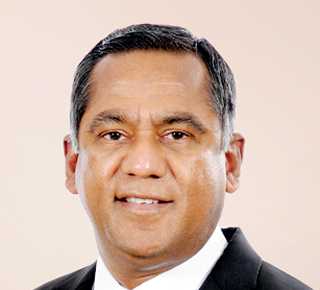Thursday Jan 08, 2026
Thursday Jan 08, 2026
Thursday, 16 May 2019 00:10 - - {{hitsCtrl.values.hits}}
Sampath Bank reported a net interest income of Rs. 10.2 billion for Q1 2019, reflecting a noteworthy growth of 23.2% over the figure reported in Q1 2018, a significant achievement given the challenging economic conditions that prevailed throughout the period. The bank recorded a profit after tax of Rs. 2.2 billion, a negative growth over the corresponding period in 2018, due to several factors including higher impairment provisions, volatile interest rates, currency uncertainty and higher taxes including a Debt Repayment Levy all of which worked against growth in Q1 2019.
 |
Chairman Professor Malik Ranasinghe |
 |
Managing Director Nanda Fernando |
Over and above this, the economic slowdown also had a domino effect causing a negative impact on the bank’s business expansion strategies.
Meanwhile the Sampath Bank Group reported a Group profit after tax of Rs. 2.1 billion.
The comparative figure for Q1 2018
In order to improve the comparability and the consistency of the Group’s Financial Statements, the bank adjusted comparative figures disclosed in Q1 2018 related to collective impairment provision based on Sri Lanka Accounting Standard – SLFRS 9 (Financial Instruments).
Fund based income (FBI)
Net Interest Income (NII), which is the main source of income representing more than 79% of the bank’s total operating income, recorded a significant increase of Rs. 1.9 billion (23.2%) in Q1 2019 in comparison to Q1 2018. Accordingly, the bank recorded a NII of Rs.10.2 billion in Q1 2019, as against Rs. 8.3 billion recorded for Q1 2018.
The above achievement was made possible due to timely re-pricing of asset and liability products and other fund management strategies adopted by the bank. The decision by the regulator to reduce the SRR from 7.5% to 6.0% with effect from 16 November 2018 followed by a further reduction to 5% with effect from 1 March also had a positive impact on NII. The bank managed to improve its NIM from 4.41% as at 31 December 2018 to 4.54% in Q1 2019.
Non-fund based income (NFBI)
Net fee and commission income, which largely comprises of credit, trade, card and electronic channel related fees recorded Rs. 2.3 billion in the quarter under review, a marginal decline over the figure reported in Q1 2018. The decline was kept to a minimum due to the strong market uptake for innovative value additions offered through electronic channels as well as appropriate action to expand credit card operations.
The net gain from financial investments recorded a marginal growth of 1.4%, due to increases in dividend income earned from financial assets. The Sri Lankan rupee, which depreciated against the US dollar during Q1 2018 by Rs. 2.00 and showed an appreciation of Rs. 7.00 in Q1 2019, had a significant impact on the bank’s total exchange income for Q1 2019, which declined by Rs. 858 million for the quarter. Net trading income recorded a strong growth and stood at Rs. 1.5 billion for the quarter under review, bolstered by significant revaluation gains on forward contracts. This was the result of tactical strategies to maximise forward contract margins in a highly volatile exchange rate environment.
Other operating income decreased by 191% owing to the exchange loss recorded in Q1 2019 due to the sharp appreciation of the Sri Lankan Rupee against the US Dollar. Consequently, the Bank recorded a loss of Rs. 1.2 billion for Q1 2019 under the other operating income category.
Operating expenses
The bank’s operating expenses, which amounted to Rs. 4.7 billion in 1Q 2018, increased to Rs. 5.1 billion during the period under review, reflecting a YoY increase of 9.9%. Higher personnel expenses triggered by salary increments and an increase in other operating expenses driven by business expansion together with inflation-led general price hikes were the main reasons for the aforesaid cost escalation. Consequently, the cost-to-income ratio excluding DRL, VAT and NBT on financial services show a marginal increase of 0.1% from 39.5% in 1Q 2018 to 39.6% in 1Q 2019.
Impairment charge on loans and receivables
Highly volatile economic and political conditions prevailing in the country affected many key economic sectors since 2018. This trend continued in 2019 as well, undermining the financial performance of many businesses. Consequently, non-performing advances of all banks including Sampath Bank which was on the rise throughout 2018 continued to further increase in Q1 2019 as well. As a result, Sampath Bank’s NPA increased to 4.87% in Q1 2019 from 3.69% reported as at 31st December 2018. Despite the challenging conditions however, the Bank was able to control the growth of non-performing advances by taking proactive measures throughout the period.
As a result of the increase in non-performing advances, the impairment charge of individually significant customers increased from Rs. 0.5 billion in Q1 2018 to Rs. 1.5 billion in Q1 2019. The collective impairment charge also increased to Rs. 1.8 billion in Q1 2019 compared to Rs. 1.4 billion recorded in Q1 2018, mainly due to the portfolio deterioration.
Tax expenses
The bank recorded a total tax charge of Rs. 2.2 billion for Q1 2019 which is 50% of the operating profit before taxes on financial services (including Debt Repayment Levy of Rs. 485 million). The Government has removed most of the tax concessions previously enjoyed by the banking industry via the new Inland Revenue Act that came into effect on 1 April 2018 and even thereafter continued to introduce new taxes such as the Debt Repayment Levy in October 2018. As a result, the bank was liable to pay a substantially higher amount of taxes in Q1 2019 compared with previous quarters, despite the tax reversal on account of the new exemption granted on SLDB interest income with retrospective effect.
Business growth
Sampath Bank’s total asset base stood at Rs. 911 billion as at 31 March (Rs. 914 billion as at 31 December 2018). Gross loans and receivables from other customers recorded a marginal growth of 0.9% (annualised 3.6%) during the period by moving up to Rs. 674 billion as at 31 March (up by Rs. 6 billion from the position reported as at 31 December 2018). Deposits from other customers too increased by Rs. 5.2 billion, recording a marginal growth of 0.8% (annualised 3.2%) during this period to touch Rs. 696 billion as at the reporting date. The CASA ratio as at 31 March stood at 33.5%, recording a slight improvement compared to the position as at 31 December 2018 (33.4%).
Performance ratios
Return on Assets (ROA) before income tax for Q1 2019 declined to 1.27% compared to 2.13% reported in 2018 and Return on Equity (ROE) after income tax also declined, from 16.02% as at 31 December 2018 to 10.38% in Q1 2019. The reduction in these ratios is the result of lower profitability coupled with a 31% increase in the average equity base as a result of a rights issue in April 2018. The Statutory Liquid Asset Ratio (SLAR) for the Domestic Banking Unit and the Off-Shore Banking Unit were both maintained well above the mandatory requirement of 20% throughout Q1 2019, and ended up at 22.82% and 28.36% respectively as at 31 March.
Capital adequacy
The Bank’s Common Equity Tier I Capital, Tier I Capital and Total Capital Adequacy ratios as at 31 March was at 11.72%, 11.72% and 16.19% levels respectively, all well above the minimum regulatory requirement of 8.5%, 10.0% and 14.0% respectively, applicable as at the reporting date.